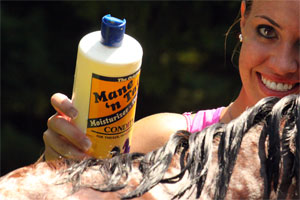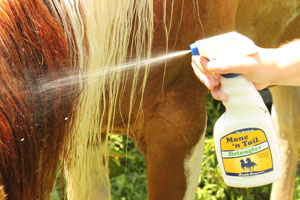Home > Horse Care > Grooming > How to Bathe a Horse Like a Pro
How to Bathe a Horse Like a Pro
- July 31, 2019
- ⎯ Mane 'n Tail
When, in the course of equine events, it becomes necessary to bathe your horse… well, have fun with that! Because let’s face it: Horses love to roll in mud, grass, and manure—especially right before a big competition.
It might seem daunting to transform your 1,200-pound, mud-covered beast into a gleaming show-ring star, but you can do it.
Horse Bathing Tips
First, assemble your supplies, starting with a hose that has an adjustable nozzle (or a big tub, if you don’t have access to running water), a stepstool, and a couple of buckets. Next, collect the following:
- a rubber scrubbing mitt
- at least 4 big half-moon sponges (1 for the body, 1 for under the tail, 1 for rinse water and 1 for drying the legs and other areas that can’t be scraped)
- an equine shampoo
- a scraper (tip: wooden ones are gentler than plastic or metal ones)
- 2 bath-sized towels
- a helper to hold your horse if he dislikes baths or won’t tie quietly
Like shampoos for humans, some equine shampoos are formulated to address specific skin issues, enhance colors, whiten, add optical brighteners, etc. Because many horses have allergies, it’s wise to perform a “patch test” on a small area of your horse’s skin before washing his entire body with a new shampoo. If his skin remains reaction-free after a day, proceed as usual.
Bathing also tends to dry the skin, causing itchiness than can lead to rubbing. Use of a conditioning shampoo (example: Mane ‘n Tail’s Original or Ultimate Gloss shampoo) can help. So can minimizing the length of time the shampoo sits on his skin. Try soaping and rinsing his body one side at a time, for example.
How to Wash a Horse
Before bath time, brush as much dirt as possible from your horse’s coat. Then, either fill a bucket or tub with moderately warm water or set your hose on “shower/spray” and check the temperature of the stream (comfort is key).
If you’ve ever washed a car, you know how important pre-rinsing is. It’s the same with a horse (even if yours is more like a Mini than a Range Rover!). Using either a sponge or the hose, thoroughly wet his coat all over, avoiding his head. Start with his feet and work gradually upward and outward. (Tip: If using a hose, always aim it away from his head.)
Next, douse the underside of your horse’s body, including the genital area and under his tail (use a gentle stream here), as well as between the legs. Last but not least, soak the mane and tail.
How to Lather a Horse
Now for the lather! Drop one of your sponges into an empty bucket, add warm water, then pour as much shampoo and water onto the sponge as it takes to create suds. Grasping the sponge, start soaping your horse’s coat in a circular motion, moving from the neck to the rump (don’t forget the legs, belly, genital area and behind the elbows). Using a different suds-soaked sponge reserved for under the tail, address that spot and the area between the hind legs. Next up: the tail and mane. Dunking the tail in your suds-filled bucket, work the soap through the hair from root to tip, adding water as needed. With a little shampoo poured into your hand, scrub the mane, making sure it’s wet enough to work up a good lather. Lastly, go over the whole body with a mitt, rewetting it often and scrubbing the suds into the skin
How to Rinse a Horse
Getting the soap out of your horse’s coat is as important as getting it in! Residue left on the skin, particularly on the back and stomach, can lead to irritation.
Using either the hose or that third sponge soaked in a bucket of clear warm water, start rinsing the suds out from the front legs to the shoulder. Continue down the neck and mane, taking care to avoid your horse’s head, and move on to the back, flanks, underside and legs.
Lifting the tail, continue rinsing between the hind legs and then hose or sponge the tail, pulling the hairs apart with your finger to check for leftover soap suds.
How to Wash a Horse’s Head
We’ve saved the trickiest part—the head—for last. Now that your horse has become accustomed to water elsewhere on his body, dunk your “rinse” sponge in fresh, warm water, wring it out and, stepping onto your stepstool, go over the entire face, head and behind the ears (being careful to avoid the eyes).
Taking the soapy sponge and wringing it out to minimize dripping, follow the same path over the face, once again avoiding the eyes. The rubber mitt can be used to scrub areas that are extra-dirty.
Rinse the face with a clean sponge dipped in fresh, warm water and wrung out, continuing to rinse and wring as you go. Give the face and head one last onceover with a clean, wet but wrung-out sponge, wiping out the nostril area, as well. (This sponge should be washed in hot water afterward.)
How to Condition a Horse’s Mane and Tail

Now is a good time to apply an equine conditioner to the mane and tail to keep them healthy-looking and easier to comb. Towel dry them first to remove excess water; then apply the conditioner, combing it through from root to tail and rinsing it out after 15 minutes or so.
The drier and more brittle the hair, the more often you’ll want to apply conditioner—just as you do with your own hair—to soften it up. Tail hair in particular can benefit from nourishing moisturizers like those in Mane n’ Tail’s Original or Ultimate Gloss conditioners.
How to Dry a Horse’s Mane and Tail
If only one could blow-dry a horse! (Please don’t try this at home!) Your sweat scraper is your best bet for this task. Starting on your horse’s neck and always scraping in the direction of hair growth, remove the excess water from the body. Then change to your fourth sponge (the dry one) to absorb extra water from the legs, which are too bony and sensitive for scraping.
Finally, towel-dry the head, ears, body and legs (changing towels as they get saturated). Comb the mane and walk or graze your horse as he air-dries.
How to Finish a Horse’s Mane and Tail
As an important finishing touch, consider using a leave-in equine conditioner/detangler or coat polish. Most of these come in spray form and may or may not contain silicones.

Mane ‘n Tail Detangler is one example of a product that can be used daily in manes and tails to facilitate combing and minimize breakage. When it’s time to hit the spotlight, coat polishes like Mane ‘n Tail Shine-On will add that mirror finish so prized in the competition ring.
Tip: When using a coat polish, avoid spraying it on the saddle and girth areas— so your tack won’t slip out from under you! By the way, products that contain silicone can also be used on legs and the tail after your horse’s bath to help repel dirt and keep tough stains like grass and manure from setting in.





